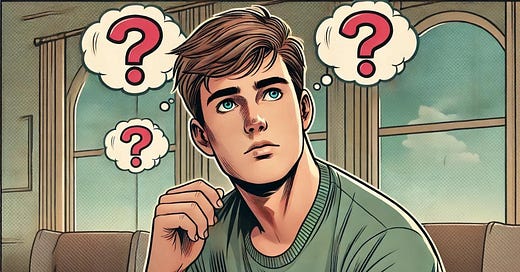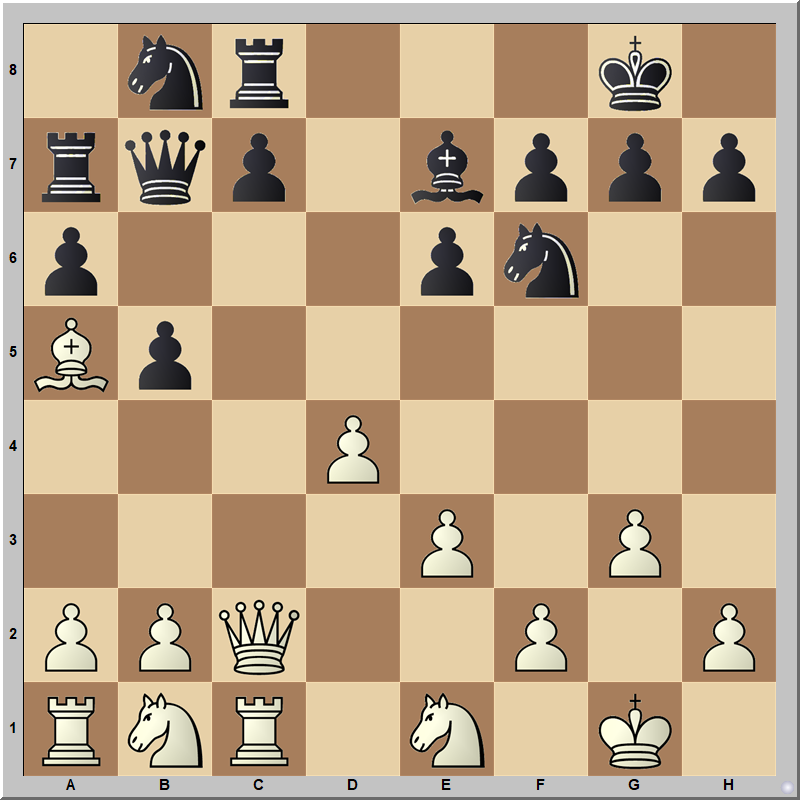Do you enjoy chess? Are you an ambitious adult improver? Become a subscriber to Chess Chatter for free to receive weekly podcast updates, challenging puzzles and insightful articles that will help you improve.
The opening is finished and you find yourself in a calm middlegame position with no tactics to be found and little calculation to consider.
What do you do?
There’s many different thinking processes and questions that you can consider in this kind of situation. There’s the Silman imbalances, the Michael de la Maza system, ChessMood’s 7Q Method and many more. Even as I’m typing this. I just got an email about Nick Vasquez’s 3x3 Method.
One of my favorite thinking systems that I use in many of my games is one that GM Jacob Aagaard recommends. He focuses on the following three questions:
Where are the weaknesses?
Which is the worst-placed piece?
What is your opponent’s idea?
I first heard about these three questions when I worked through his classic book “Grandmaster Preparation - Positional Play” a while back. After that, I was able to get more practice and exposure to them when I was a member of the Killer Chess Training academy which GM Aagaard runs.
As mentioned in the Positional Play book:
The purpose of the three questions is to direct your focus
The first question “Where are the weaknesses?” is meant to get us to look for the specific problems in both our own side of the board and in our opponent’s side of the board.
Do we have a weak king?
Does our opponent have a long-term pawn weakness?
Is there a weak square that could potentially be used as an outpost for a piece?
These are just a few examples of sub-questions we could consider revolving around the “weaknesses” in the position.
If we identify a weakness for ourselves then a move and plan we might consider is trying to trade off or eliminate our weakness. Conversely, if our opponent has a weakness then a move and plan we might consider is attacking that particular weakness.
This first question can be boiled down to the word “weakness”.
The second question “Which is the worst-placed piece?” is fairly straightforward: Identify which piece of your own is not well-placed or is ineffective in the current position and figure out a way of improving that piece to a better location. This kind of question could also be considered for our opponent.
Once we figure out which of our pieces is not well placed then a move and plan we might consider is to improve this piece or trade it off. On the other side of the board, if our opponent has a badly placed piece then a move and plan we might consider is preventing them from improving or trading it.
This second question can be boiled down to the word “pieces”.
This leads us to the third question “What is your opponent’s idea?”.
At it’s core, positional chess is all about two things:
Improving our position
Worsening our opponent’s position
If our opponent has a specific idea or plan they want to execute in a position then preventing that plan from happening would fall into the second category. We would be worsening our opponent’s position because their improvement is harder to accomplish.
Trying to figure out what our opponent’s idea or plan in a position might be can directly be tied into the first two questions of the three. Remember, not only were we thinking about the answers to those questions for ourselves but also for our opponent!
Example: In answering question #1, we may see that our opponent has a weak pawn. It could be that their idea/plan is to trade off their pawn weakness. If we can prevent this plan from happening then that would make their life more difficult since they would be stuck with the weak pawn.
Another example: In answering question #2, we may recognize that our opponent has a badly placed bishop and their idea/plan might be to trade off this piece. If we can prevent this plan from happening then that would make their life more difficult since they would be stuck with the bad piece.
Preventing your opponent’s idea is the definition of “prophylaxis”. With that being the case, the third question could be boiled down to the word “prophylaxis”, “prevent” or simply “opponent”.
Let’s take a look at three different positions where we can work to answer these questions and how thinking through them can help us to identify the best move:
Question #1: Where are the weaknesses? What move might we consider that would revolve around this?
Answer: White’s d4-pawn is isolated (weak). Black’s e6-pawn is backwards (weak). A move Black might consider is 1…Bf6 to attack the d4-pawn.
Question #2: Which is the worst-placed piece? What move might we consider that would revolve around this?
Answer: Our bishop on d8 is clearly our worst-placed piece. Bishops usually don’t belong on the back rank! A move Black might consider is 1…Bf6 to improve the bishop (notice a trend?)
Question #3: What is your opponent’s idea? What move might we consider that would prevent this idea?
Answer: I think White may want to play 1. Ne5 next in order to get their knight to a strong square in the center and attack our queen. A move Black might consider against this is 1…Bf6 with the possibility of trading for the knight if White continues with 2. Ne5.
I think we can conclude that the move 1…Bf6 makes a ton of sense here. It’s a very nice multi-purpose move that checks all the boxes and goes along with all three of these questions. The computer gives this move an evaluation of -1.3 and the second-best move (1…Re8) is given as -0.4.
In the game Black did indeed play 1…Bf6! attacking the d4-pawn. White ended up blundering immediately with 2. Bc3?? Nxc3 3. bxc3 Rxc3! winning material due to the …Bxd4+ fork coming next.
Question #1: Where are the weaknesses? What move might we consider that would revolve around this?
Answer: Black doesn’t have any big weaknesses. Potentially the b7-pawn is undefended and the f7-pawn is a target in front of black’s king. A move we might consider is 1. Rb1 hitting b7 or 1. Rh3-f3 with the plan to attack f7.
Question #2: Which is the worst-placed piece? What move might we consider that would revolve around this?
Answer: Our rooks are both pretty passive and our f1-bishop hasn’t developed yet. Also, the bishop on d2 isn’t terribly active. Pretty much every piece of ours is bad except the queen! Moves we might consider are 1. Rb1, 1. Rh3, 1. Bd3 or 1. Bb4.
Question #3: What is your opponent’s idea? What move might we consider that would prevent this idea?
Answer: I think Black may want to play 1…Bb5 to trade off their bad light-square bishop for our good light-square bishop. To prevent this we may consider the move 1. Rb1 to prevent …Bb5 from happening. Another idea they could play is 1…Rc8 to attack our c2-pawn. However, we don’t really have a way to prevent them from playing …Rc8.
Which move checkmarks multiple boxes?
To my eyes it looks like 1. Rb1 does the most work in the position. It attacks the b7-pawn, activates an inactive piece and prevents …Bb5 at the same time. Indeed, 1. Rb1! is the best move in the position with an engine evaluation of +2.5 compared to the second-best move (1. Rh3) being +0.75. Notice though, that both of these moves are multi-purpose and pretty good. 1. Rh3 was improving a badly placed piece with the goal of playing Rf3 and attacking the f7-pawn target. The only downside of Rh3 is that it didn’t prevent …Bb5 and this is the main reason that 1. Rb1 is better than 1. Rh3.
All this being said, White sadly did not play 1. Rb1 and actually did play 1. Rh3!? which allowed 1…Ng6 2. Qe3 Bb5 and Black escaped with a draw later.
Question #1: Where are the weaknesses? What move might we consider that would revolve around this?
Answer: Black’s c7-pawn is backwards and has a lot of pieces stuck defending it (all three heavy pieces are tied down to it right now). Unfortunately for White, we don’t have a way of attacking it an additional time from the current position.
Question #2: Which is the worst-placed piece? What move might we consider that would revolve around this?
Answer: Our knight on e1 is clearly our worst-placed piece. While it’s true that the knight on b1 and rook on a1 haven’t moved yet, the knight on e1 has moved a few times to reach that square and needs to be improved. A move White might consider is 1. Nd3 to improve the knight. Another option is 1. Nd2 or 1. Nc3 to develop the queenside knight.
Question #3: What is your opponent’s idea? What move might we consider that would prevent this idea?
Answer: I think Black would love to play 1…c5 next move in order to trade off their weak backwards c7-pawn. If the c-pawn gets traded off then Black wouldn’t have a weakness anymore and would be able to develop the rest of their pieces a bit easier. A move White might consider against this is 1. Nd3 or 1. b4 to gain more control over the c5-square.
All things considered, it looks like 1. Nd3 does a good job of improving a poorly placed piece and preventing the opponent’s idea of …c5 at the same time. And it does end up being the case that 1. Nd3 is one of the two best moves in the position. Objectively, 1. b4 is a tad bit stronger according to the computer (0.65) compared to 1. Nd3 (0.60) but it is such a small difference that I would really think that 1. Nd3 is the more logical move of the two since it checkmarks multiple boxes.
In the game White did indeed play 1. Nd3! but went on to draw the game later despite having a more pleasant position in the first place.
Notice that by asking these three questions in each position, we were able to come up with logical and strong moves. I think it could be very helpful if you try putting these questions to use yourself when you are stuck in a middlegame and don’t know what to do.
I hope you’ve enjoyed this article. See you in the next post!








![Table of Contents [Start Here]](https://substackcdn.com/image/fetch/$s_!DPKc!,w_140,h_140,c_fill,f_auto,q_auto:good,fl_progressive:steep,g_auto/https%3A%2F%2Fsubstack-post-media.s3.amazonaws.com%2Fpublic%2Fimages%2F69f371ff-f03d-4dd1-b553-6dbf1423b4ac_1024x847.jpeg)
Aagaard's 3 questions are a great way of thinking, and one I've tried to use. However, it's my opinion that to use them well requires some level of skill and knowledge. Will the typical 1200 be able to spot weaknesses and know how to exploit them? Not sure. Checklists are just there for folks whose skill level aren't quite there yet. Would you agree?